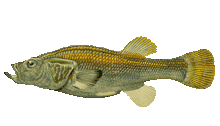Orestias (fish)
| Orestias | |
|---|---|
 | |
| Orestias cuvieri | |
| Scientific classification | |
| Kingdom: | Animalia |
| Phylum: | Chordata |
| Class: | Actinopterygii |
| Order: | Cyprinodontiformes |
| Family: | Cyprinodontidae |
| Genus: | Orestias Valenciennes, 1839 |
Orestias is a genus of pupfish. Older systematics classified them into the own family Orestiidae. They are found in lakes, rivers and springs in the Andean highlands of South America, and several species are considered threatened.[1] Depending on exact species, they feed on small crustaceans (such as amphipods and cladocera), insect larvae (such as chironomids), snails, small fish and algae.[2] The largest species can reach a length of 27 cm (11 in), but most remain far smaller.[3] Their most characteristic feature is the absence of the ventral fin.
Several species are colloquially known as carache.
Range and habitat
Orestias is restricted to freshwater habitats at an altitude of 2,800–4,600 m (9,200–15,100 ft) in the Andes of central and southern Peru, western Bolivia, and northeastern Chile.[1] Of the 45 recognized species, the majority are found in Lake Titicaca (including 23 endemics), with the remaining from other Altiplano lakes, rivers or springs.[1] In addition to differences in feeding, the many species in Lake Titicaca segregate by habitat preference, with some living among totora reeds, some among submerged macrophytes, some at the bottom in water too deep for macrophytes (deeper than 10 m or 33 ft), and some pelagically in the open water.[4] Orestias species found elsewhere than Lake Titicaca often have very small ranges.[1]
Status
Many species of the genus became rare in recent decades due to competition with introduced fish species, pollution, and human activities at the lakes. One species—the Titicaca Orestias (Orestias cuvieri)—was last seen in 1939 and is probably extinct; several others are known to have highly restricted ranges.[5]
Species
There are currently 45 recognized species in this genus,[3] divided by American ichthyologist Lynne R. Parenti in 1984 depending on their relationships into four species complexes. The genus is estimated to be 5 million years old, with a significant diversification occurring within the last one million years. Lüssen (2003) researched the phylogeny of several species including mtDNA sequence data; because hybridization is known to occur (Villwock 1964, Parenti 1984), mtDNA data cannot be relied upon on its own to resolve the evolution of this genus.
Agassii species complex
- Orestias agassizii Valenciennes, 1846 (Carache Negro)
- Orestias albus Valenciennes, 1846 (Carache Amarillo)
- Orestias ascotanensis Parenti, 1984
- Orestias chungarensis Vila & M. Pinto, 1987
- Orestias ctenolepis Parenti, 1984
- Orestias elegans Garman, 1895
- Orestias empyraeus W. R. Allen, 1942
- Orestias frontosus Cope, 1876
- Orestias gloriae Vila, S. Scott, Méndez, Valenzuela, Iturra & Poulin, 2012[6]
- Orestias gymnotus Parenti, 1984
- Orestias hardini Parenti, 1984
- Orestias jussiei Valenciennes, 1846 (Carache Amarillo)
- Orestias lastarriae Philippi {Krumweide}, 1876
- Orestias laucaensis Arratia, 1982
- Orestias luteus Valenciennes, 1846 (Carache Amarillo)
- Orestias multiporis Parenti, 1984
- Orestias mundus Parenti, 1984
- Orestias olivaceus Garman, 1895
- Orestias parinacotensis Arratia, 1982
- Orestias piacotensis Vila, 2006
- Orestias polonorum Tchernavin, 1944
- Orestias puni Tchernavin, 1944
- Orestias richersoni Parenti, 1984
- Orestias silustani W. R. Allen, 1942
- Orestias tschudii Castelnau, 1855
- Orestias ututo Parenti, 1984
Cuvieri species complex
- Orestias cuvieri Valenciennes, 1846 (Titicaca Orestias, Amanto; extinct (mid-20th century))
- Orestias forgeti Lauzanne, 1981 (Ispi)
- Orestias ispi Lauzanne, 1981 (Ispi)
- Orestias pentlandii Valenciennes, 1846 (Boga)
Gilsoni species complex
- Orestias gilsoni Tchernavin, 1944
- Orestias imarpe Parenti, 1984
- Orestias minimus Tchernavin, 1944
- Orestias minutus Tchernavin, 1944
- Orestias mooni Tchernavin, 1944
- Orestias robustus Parenti, 1984
- Orestias taquiri Tchernavin, 1944
- Orestias tchernavini Lauzanne, 1981
- Orestias tomcooni Parenti, 1984
- Orestias uruni Tchernavin, 1944
Mulleri species complex
- Orestias crawfordi Tchernavin, 1944
- Orestias gracilis Parenti, 1984
- Orestias incae Garman, 1895
- Orestias mulleri Valenciennes, 1846
- Orestias tutini Tchernavin, 1944
References
- 1 2 3 4 Vila, Morales, Scott, Poulin, Veliz, Harrod and Mendez (2013). Phylogenetic and phylogeographic analysis of the genus Orestias (Teleostei: Cyprinodontidae) in the southern Chilean Altiplano: the relevance of ancient and recent divergence processes in speciation. Journal of Fish Biology 82, 927–943.
- ↑ Maldonado, E. E., Hubert, N. N., Sagnes, P. P., & De MÉrona, B. B. (2009). Morphology–diet relationships in four killifishes (Teleostei, Cyprinodontidae, Orestias) from Lake Titicaca. Journal of Fish Biology, 74(3), 502-520. doi:10.1111/j.1095-8649.2008.02140.x
- 1 2 Froese, Rainer, and Daniel Pauly, eds. (2012). Species of Orestias in FishBase. August 2012 version.
- ↑ Lauzanne, L. (1992). Fish Fauna. Pp. 405-448 in: Dejoux, C., eds. (1992). Lake Titicaca: a synthesis of limnological knowledge. ISBN 0-7923-1663-0
- ↑ Parenti, Lynne R. (1984): A taxonomic revision of the Andean Killifish Genus Orestias (Cyprinodontiformes, Cyprinodontidae). Bulletin of the American Museum of Natural History 178: 107-214. PDF fulltext
- ↑ Vila, I., Scott, S., Mendez, M.A., Valenzuela, F., Iturra, P. & Poulin, E. (2012): Orestias gloriae, a new species of cyprinodontid fish from saltpan spring of the southern high Andes (Teleostei: Cyprinodontidae). Ichthyological Exploration of Freshwaters, 22 (4) [2011]: 345-353.
- Lüssen, Arne (2003): Zur Systematik, Phylogenie und Biogeographie chilenischer Arten der Gattung Orestias VALENCIENNES, 1839. Doctoral thesis, University of Hamburg, Germany. [in German] PDF fulltext
- Villwock, W. (1964): Vermeintliche Artbastarde in der Gattung Orestias (Pisces, Cyprinodontidae). Mitteilungen aus dem Hamburgischen Zoologischen Museum und Institut, Kosswig-Festschrift: 285-291. [Article in German]
- Villwock, W. (1972): Gefahren für die endemische Fischfauna durch Einbürgerungsversuche und Akklimatisation von Fremdfischen am Beispiel des Titicacas-Sees (Peru/Bolivien) und des Lanao-Sees (Mindanao/Philippinen). Verhandlungen des Internationalen Vereins für Limnologie 18: 1227-1234. [Article in German]